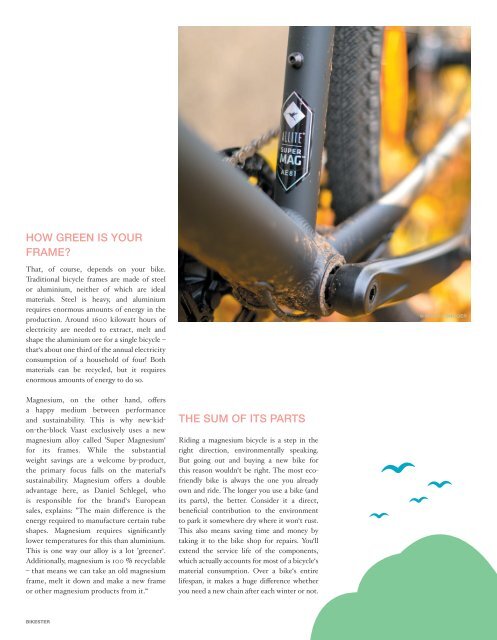Bikester Magazine EN Summer 2021
2020 was a tremendous year for cycling: a record number of people started riding and, thanks to that, can now get about more quickly and have more fun doing so than ever before. In this issue, we explore what can help continue this exciting trend: whether that's better infrastructure, going on exciting bike tours or bringing the right food with you. Let's enjoy as many places as possible by bike in 2021!
2020 was a tremendous year for cycling: a record number of people started riding and, thanks to that, can now get about more quickly and have more fun doing so than ever before. In this issue, we explore what can help continue this exciting trend: whether that's better infrastructure, going on exciting bike tours or bringing the right food with you. Let's enjoy as many places as possible by bike in 2021!
You also want an ePaper? Increase the reach of your titles
YUMPU automatically turns print PDFs into web optimized ePapers that Google loves.
HOW GRE<strong>EN</strong> IS YOUR<br />
FRAME?<br />
That, of course, depends on your bike.<br />
Traditional bicycle frames are made of steel<br />
or aluminium, neither of which are ideal<br />
materials. Steel is heavy, and aluminium<br />
requires enormous amounts of energy in the<br />
production. Around 1600 kilowatt hours of<br />
electricity are needed to extract, melt and<br />
shape the aluminium ore for a single bicycle –<br />
that‘s about one third of the annual electricity<br />
consumption of a household of four! Both<br />
materials can be recycled, but it requires<br />
enormous amounts of energy to do so.<br />
© MARTIN OHLIGER<br />
Magnesium, on the other hand, offers<br />
a happy medium between performance<br />
and sustainability. This is why new-kidon-the-block<br />
Vaast exclusively uses a new<br />
magnesium alloy called ’Super Magnesium‘<br />
for its frames. While the substantial<br />
weight savings are a welcome by-product,<br />
the primary focus falls on the material‘s<br />
sustainability. Magnesium offers a double<br />
advantage here, as Daniel Schlegel, who<br />
is responsible for the brand‘s European<br />
sales, explains: ”The main difference is the<br />
energy required to manufacture certain tube<br />
shapes. Magnesium requires significantly<br />
lower temperatures for this than aluminium.<br />
This is one way our alloy is a lot ’greener‘.<br />
Additionally, magnesium is 100 % recyclable<br />
– that means we can take an old magnesium<br />
frame, melt it down and make a new frame<br />
or other magnesium products from it.“<br />
THE SUM OF ITS PARTS<br />
Riding a magnesium bicycle is a step in the<br />
right direction, environmentally speaking.<br />
But going out and buying a new bike for<br />
this reason wouldn‘t be right. The most ecofriendly<br />
bike is always the one you already<br />
own and ride. The longer you use a bike (and<br />
its parts), the better. Consider it a direct,<br />
beneficial contribution to the environment<br />
to park it somewhere dry where it won‘t rust.<br />
This also means saving time and money by<br />
taking it to the bike shop for repairs. You‘ll<br />
extend the service life of the components,<br />
which actually accounts for most of a bicycle‘s<br />
material consumption. Over a bike‘s entire<br />
lifespan, it makes a huge difference whether<br />
you need a new chain after each winter or not.<br />
BIKESTER











